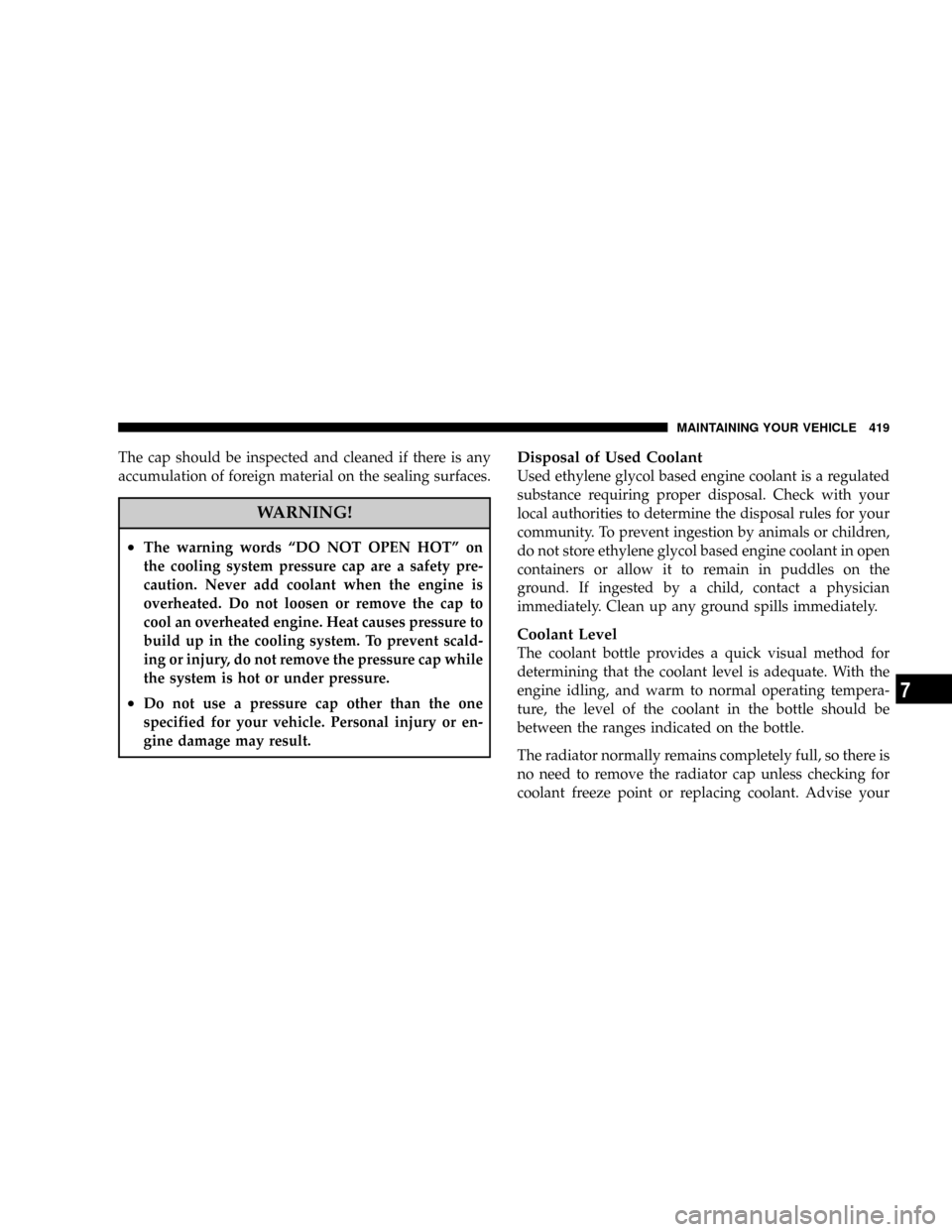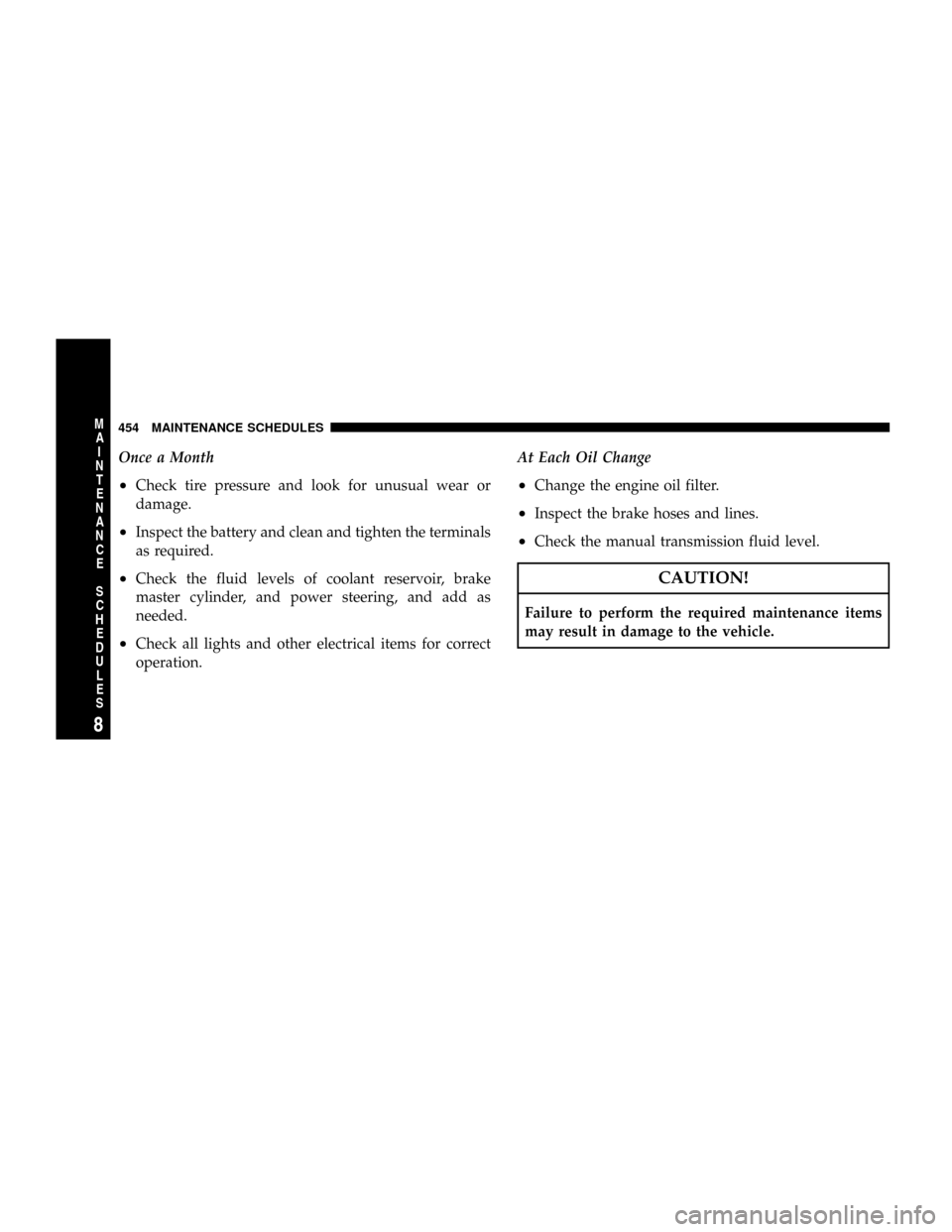2008 JEEP LIBERTY coolant level
[x] Cancel search: coolant levelPage 418 of 493

Adding Coolant
Your vehicle has been built with an improved engine
coolant that allows extended maintenance intervals. This
coolant can be used up to 5 Years or 100,000 miles (160
000 km) before replacement. To prevent reducing this
extended maintenance period, it is important that you
use the same coolant throughout the life of your vehicle.
Please review these recommendations for using Hybrid
Organic Additive Technology (HOAT) coolant.
When adding coolant:
²The manufacturer recommends using Mopart
Antifreeze/Coolant 5 Year/100,000 Mile Formula
HOAT (Hybrid Organic Additive Technology).
²Mix a minimum solution of 50% HOAT engine coolant
and distilled water. Use higher concentrations (not to
exceed 70%) if temperatures below234ÉF (237ÉC) are
anticipated.
²Use only high purity water such as distilled or deion-
ized water when mixing the water/engine coolant
solution. The use of lower quality water will reduce
the amount of corrosion protection in the engine
cooling system.
Please note that it is the owner's responsibility to main-
tain the proper level of protection against freezing ac-
cording to the temperatures occurring in the area where
the vehicle is operated.
NOTE:Mixing coolant types will decrease the life of the
engine coolant and will require more frequent coolant
changes.
Cooling System Pressure Cap
The cap must be fully tightened to prevent loss of
coolant, and to insure that coolant will return to the
radiator from the coolant recovery bottle.
418 MAINTAINING YOUR VEHICLE
Page 419 of 493

The cap should be inspected and cleaned if there is any
accumulation of foreign material on the sealing surfaces.
WARNING!
²The warning words ªDO NOT OPEN HOTº on
the cooling system pressure cap are a safety pre-
caution. Never add coolant when the engine is
overheated. Do not loosen or remove the cap to
cool an overheated engine. Heat causes pressure to
build up in the cooling system. To prevent scald-
ing or injury, do not remove the pressure cap while
the system is hot or under pressure.
²Do not use a pressure cap other than the one
specified for your vehicle. Personal injury or en-
gine damage may result.
Disposal of Used Coolant
Used ethylene glycol based engine coolant is a regulated
substance requiring proper disposal. Check with your
local authorities to determine the disposal rules for your
community. To prevent ingestion by animals or children,
do not store ethylene glycol based engine coolant in open
containers or allow it to remain in puddles on the
ground. If ingested by a child, contact a physician
immediately. Clean up any ground spills immediately.
Coolant Level
The coolant bottle provides a quick visual method for
determining that the coolant level is adequate. With the
engine idling, and warm to normal operating tempera-
ture, the level of the coolant in the bottle should be
between the ranges indicated on the bottle.
The radiator normally remains completely full, so there is
no need to remove the radiator cap unless checking for
coolant freeze point or replacing coolant. Advise your
MAINTAINING YOUR VEHICLE 419
7
Page 420 of 493

service attendant of this. As long as the engine operating
temperature is satisfactory, the coolant bottle need only
be checked once a month.
When additional coolant is needed to maintain the
proper level, it should be added to the coolant bottle. Do
not overfill.
Points To Remember
NOTE:When the vehicle is stopped after a few miles
(kilometers) of operation, you may observe vapor coming
from the front of the engine compartment. This is nor-
mally a result of moisture from rain, snow, or high
humidity accumulating on the radiator and being vapor-
ized when the thermostat opens, allowing hot coolant to
enter the radiator.
If an examination of your engine compartment shows no
evidence of radiator or hose leaks, the vehicle may be
safely driven. The vapor will soon dissipate.
²Do not overfill the coolant bottle.
²Check coolant freeze point in the radiator and in the
coolant recovery bottle. If coolant needs to be added,
contents of coolant recovery bottle must also be pro-
tected against freezing.
²If frequent coolant additions are required, or if the
level in the coolant recovery bottle does not drop when
the engine cools, the cooling system should be pres-
sure tested for leaks.
²Maintain coolant concentration at 50% HOAT engine
coolant (minimum) and distilled water for proper
corrosion protection of your engine, which contains
aluminum components.
²Make sure that the radiator and coolant recovery
bottle hoses are not kinked or obstructed.
420 MAINTAINING YOUR VEHICLE
Page 447 of 493

FLUID CAPACITIES
U.S. Metric
Fuel (approximate)
3.7 Liter Engine 19.5 Gallons 73.8 Liters
Engine Oil-With Filter
SAE 5W-20, API Certified 5 Qts 4.7 Liters
Cooling System *
MopartAntifreeze/Coolant 5 Year/100,000 Mile Formula or equivalent. 14 Qts 13 Liters
* Includes heater and coolant recovery bottle filled to MAX level.
MAINTAINING YOUR VEHICLE 447
7
Page 454 of 493

Once a Month
²Check tire pressure and look for unusual wear or
damage.
²Inspect the battery and clean and tighten the terminals
as required.
²Check the fluid levels of coolant reservoir, brake
master cylinder, and power steering, and add as
needed.
²Check all lights and other electrical items for correct
operation.At Each Oil Change
²Change the engine oil filter.
²Inspect the brake hoses and lines.
²Check the manual transmission fluid level.
CAUTION!
Failure to perform the required maintenance items
may result in damage to the vehicle.
454 MAINTENANCE SCHEDULES
8
M
A
I
N
T
E
N
A
N
C
E
S
C
H
E
D
U
L
E
S
Page 473 of 493

Chart, Tire Sizing........................ 330
Check Engine Light (Malfunction Indicator
Light)................................ 400
Checking Your Vehicle For Safety............. 79
Checks, Safety........................... 79
Child Restraint....................69,70,74,76
Child Restraint Tether Anchors.............73,74
Child Safety Locks........................ 33
Clean Air Gasoline....................... 356
Cleaning
Windshield Wiper Blades................. 413
Climate Control......................... 260
Clock...........................224,239,243
Clutch Fluid Reservoir.................... 424
Clutch Interlocking Ignition System........... 288
Coin Holder........................... 173
Cold Weather Operation................... 278
Command-Trac Operation.................. 292
Compact Disc (CD) Maintenance............. 259Compass.............................. 212
Compass Calibration..................204,212
Compass Variance....................204,213
Computer, Trip/Travel.................... 210
Console.............................. 173
Console, Floor.......................... 173
Contract, Service........................ 462
Converter, Catalytic...................... 407
Coolant Pressure Cap (Radiator Cap).......... 418
Cooling System......................... 416
Adding Coolant (Antifreeze).............. 418
Coolant Capacity...................... 447
Coolant Level......................416,419
Disposal of Used Coolant................ 419
Drain, Flush, and Refill.................. 417
Inspection........................... 419
Points to Remember.................... 420
Pressure Cap......................... 418
Selection of Coolant (Antifreeze)......417,447,448
INDEX 473
10
Page 475 of 493

Electrical Power Outlets................... 169
Electronic Brake Control System............. 314
Anti-Lock Brake System................. 315
Brake Assist System.................... 316
Electronic Roll Mitigation................ 317
Electronic Stability Program............... 324
Traction Control System................. 316
Electronic Roll Mitigation (ERM)............. 317
Electronic Speed Control (Cruise Control)...... 147
Electronic Stability Program (ESP).........196,324
Electronic Throttle Control Warning Light...... 192
Electronic Vehicle Information Center (EVIC).... 206
Emergency, In Case of
Jacking............................. 385
Jump Starting......................... 390
Overheating.......................... 384
Towing............................. 393
Emission Control System Maintenance......400,452
Engine............................... 398Air Cleaner.......................... 406
Block Heater......................... 280
Break-In Recommendations................ 79
Checking Oil Level..................... 403
Compartment......................... 398
Coolant (Antifreeze).................416,448
Cooling............................. 416
Exhaust Gas Caution..................80,358
Fails to Start.......................... 278
Flooded, Starting...................... 278
Fuel Requirements..................... 355
Jump Starting......................... 390
Oil ...........................403,447,448
Oil Change Interval...............201,209,404
Oil Filler Cap......................... 404
Oil Filter............................ 405
Oil Filter Disposal...................... 405
Oil Selection.......................404,447
Oil Synthetic......................... 405
INDEX 475
10